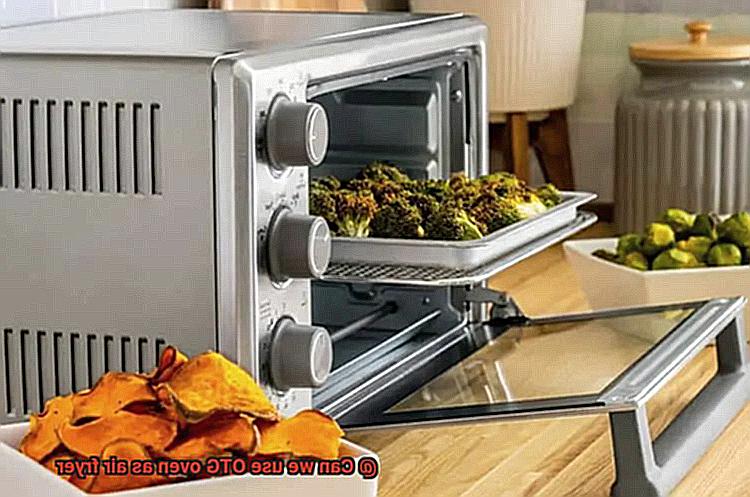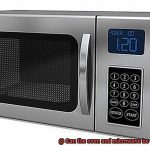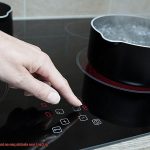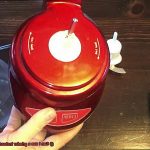Looking for a kitchen gadget that can do it all? Look no further than the electric skillet. This versatile appliance can fry, sauté, simmer, and yes – even bake. That’s right, you can bake on an electric skillet.
Now, you might be thinking, “Hold up, isn’t baking only supposed to happen in an oven?” While that’s true for most recipes, an electric skillet can be a lifesaver when you need to whip up something quick without heating up your entire kitchen.
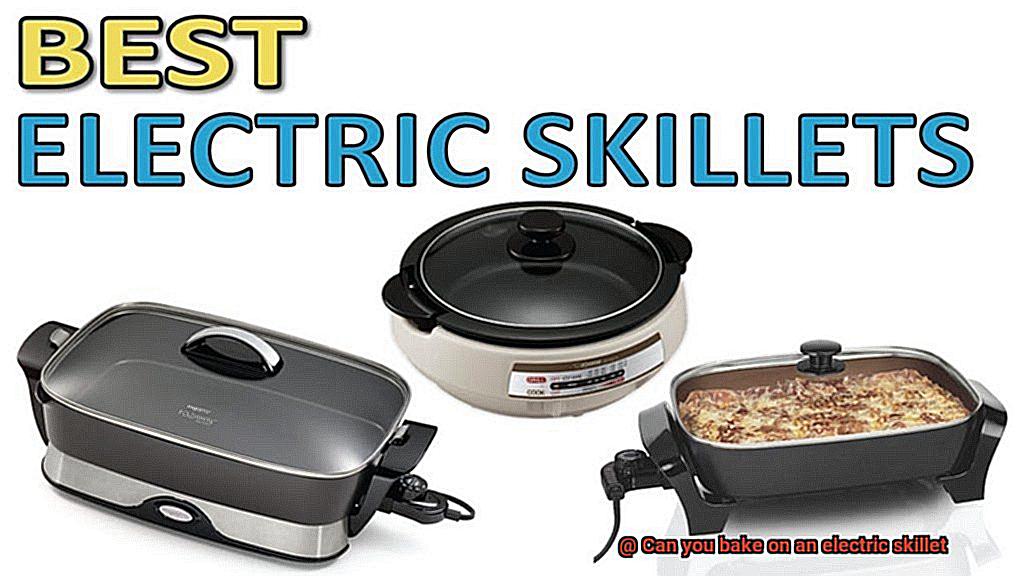
But before you start preheating your skillet, there are a few things you should know. First off, you’ll need to find the right recipe – one that doesn’t require an oven temperature over 400°F. Secondly, make sure your skillet is big enough to accommodate your baking dish. And lastly, adjust your cooking time and technique to ensure perfect results.
In this blog post, we’ll delve deeper into the details of baking on an electric skillet. We’ll cover the best types of recipes to try out and explore all the benefits of using this handy appliance. Plus, we’ll share some expert tips and tricks to help guarantee baking success every time.
So go ahead and grab your trusty skillet – let’s get cooking (or baking).
Contents
What is an Electric Skillet?
If you’re looking for a versatile kitchen appliance that can fry, sauté, simmer, grill and even bake, look no further than an electric skillet.
An electric skillet is a flat-bottomed pan with raised edges, usually made of non-stick material. Unlike traditional skillets that are placed on a stove, an electric skillet has its own heating element that allows it to be used anywhere there is an electrical outlet. With different shapes and sizes available, some even having temperature control features, removable handles and dishwasher-safe parts, an electric skillet is a great way to save time in the kitchen.
One of the best things about using an electric skillet is how quickly and evenly it heats up. This means your food will cook evenly without any hot spots. Additionally, electric skillets have a large cooking surface, allowing you to cook multiple items at once without overcrowding the pan.
But did you know that you can also bake on an electric skillet? While it may require some adjustments to your cooking methods, it’s definitely possible. Just make sure to use a baking pan or dish that fits inside the skillet and has a thick bottom for even heat distribution. And monitor your dish regularly to ensure it doesn’t burn or overcook.
Benefits of Baking on an Electric Skillet
Look no further than the electric skillet. As an expert on the benefits of baking on an electric skillet, let me enlighten you on why this kitchen appliance is a must-have.
One of the most significant benefits of using an electric skillet for baking is its versatility. With this multi-functional tool, you can fry, sauté, simmer, grill, and bake – all in one place. This not only saves you money but also frees up valuable kitchen space. Imagine being able to bake a cake while simultaneously cooking a savory dish on the same appliance.
Another great benefit of baking on an electric skillet is its even heat distribution. Unlike traditional ovens that can have hot spots or uneven heating, electric skillets distribute heat evenly across the surface area. This ensures that your baked goods cook consistently and perfectly every time. This is particularly important when baking delicate items such as cakes or pastries where minor temperature variations can affect the final product.
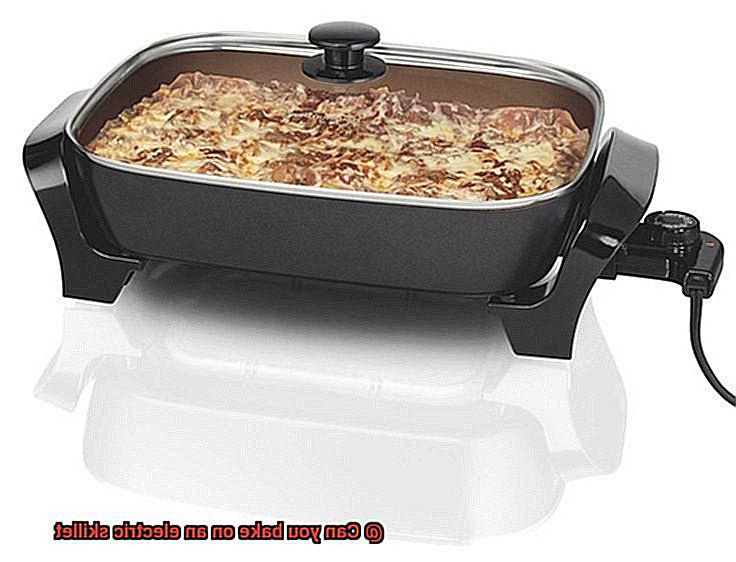
Speaking of temperature control, electric skillets offer excellent precision when it comes to adjusting the heat. You can easily set the temperature to the exact degree required for your recipe, ensuring that each item is cooked to perfection. Whether you’re making bread or cookies, this level of control will help you achieve consistent and delicious results every time.
Lastly, using an electric skillet for baking can be a faster and more energy-efficient option than using a traditional oven. Electric skillets heat up quickly and maintain their temperature with less energy than larger ovens. This means that you not only save time but also save money on your electricity bills.
Important Things to Consider Before Baking on an Electric Skillet
While it may seem daunting at first, with some careful planning and consideration, you can create mouth-watering baked goods using this versatile appliance. As an expert in the field, I am here to share some important things to keep in mind before you get started.
Firstly, it’s crucial to understand that electric skillets are not primarily designed for baking. However, with a bit of creativity and experimentation, they can still be used to bake certain types of dishes. One of the most essential considerations is temperature control. Electric skillets typically have a temperature range of 200-400°F, which may not be enough for certain baked goods such as bread and cakes. Therefore, it’s important to choose recipes that can be adapted to the temperature range of your electric skillet or invest in one with adjustable temperature controls.
Another critical factor is the size and shape of your electric skillet. Choosing an appropriate size and shape is vital for achieving optimal results when baking. For instance, if you plan to bake a round cake or a pizza, you’ll need an electric skillet with a round shape and a large enough diameter. On the other hand, if you plan to bake bread or rolls, you’ll need an electric skillet with a rectangular shape that can accommodate the size of your dough.
Additionally, it’s essential to consider the type of dish you want to bake. Some dishes are well-suited for baking on an electric skillet due to their lower cooking temperatures and longer cook times. For example, casseroles and frittatas are perfect for electric skillet baking. However, other delicate pastries and cakes may require precise temperature and humidity control that is difficult to achieve on an electric skillet.
Lastly, it’s worth noting that baking on an electric skillet may require some trial and error. Since they are not primarily designed for baking, it may take some experimentation to find the right temperature, cooking time, and other variables to achieve your desired results. However, with a bit of patience and persistence, you’ll be able to create delicious baked goods on your electric skillet in no time.
How to Bake on an Electric Skillet
Baking on an electric skillet can be a convenient and efficient way to make delicious baked goods at home. Whether you’re short on time, oven space, or just looking for a new way to bake, an electric skillet can come in handy. Here are five sub-sections to help you master the art of baking on an electric skillet:
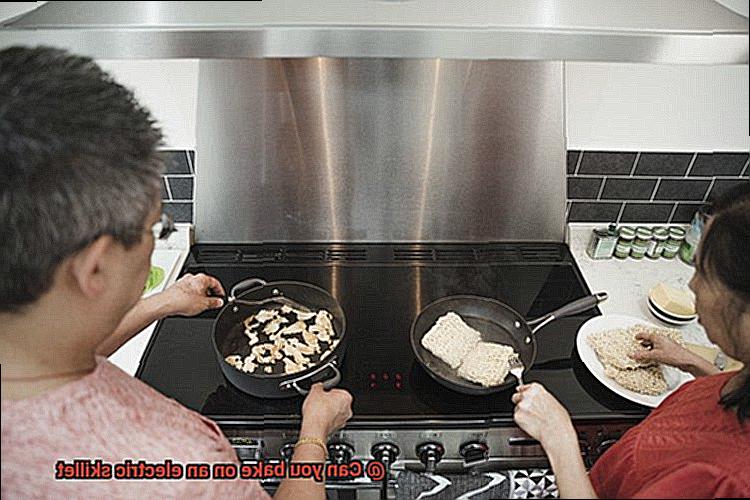
Gather Your Tools and Ingredients
Before you start baking, make sure you have all the necessary tools and ingredients. You’ll need an electric skillet with a lid and temperature control setting, as well as baking ingredients such as flour, sugar, eggs, and butter. Parchment paper or cooking spray can also be helpful for preventing sticking.
Preheat the Skillet
Preheating your electric skillet is a crucial step in ensuring that your baked goods cook evenly. Set your skillet to the desired temperature and let it heat up for at least 10 minutes before adding your batter or dough.
Choose the Right Pan or Dish
Using a heat-resistant pan or dish that fits comfortably inside your electric skillet is essential for successful baking. Make sure that the pan or dish you choose is suitable for the type of baked goods you’re making and that it’s safe to use on an electric skillet.
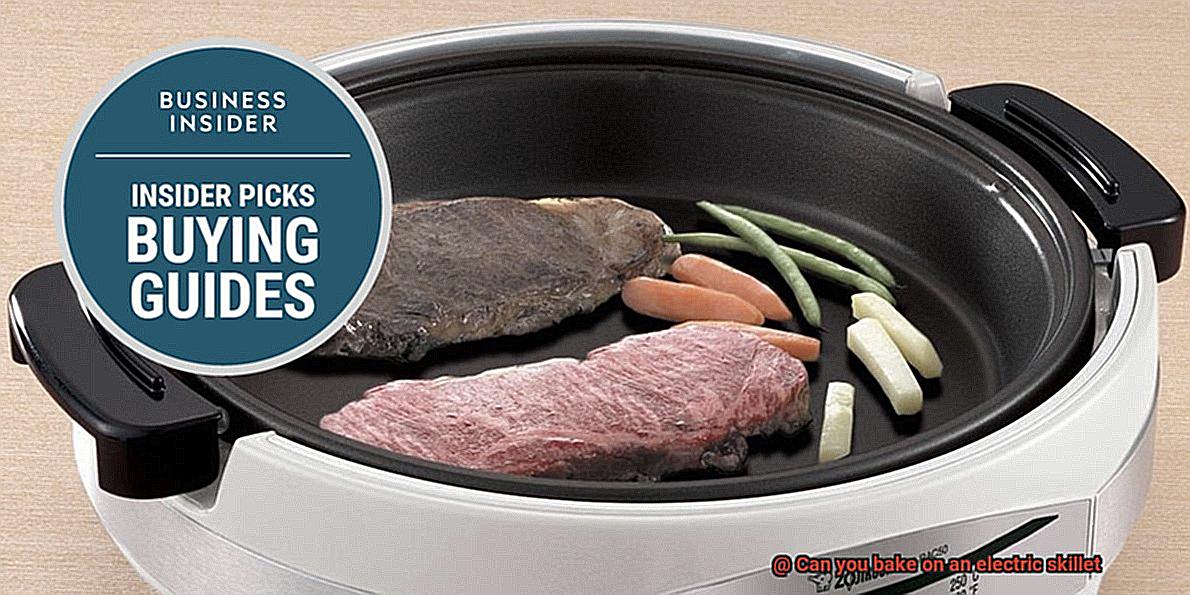
Monitor Progress and Adjust Temperature as Needed
Once your batter or dough is in the pan or dish and covered with a lid or foil, it’s important to monitor its progress regularly. Opening the lid too often can cause heat loss, so try to resist the temptation to peek too often. If you notice that your baked goods are browning too quickly on the bottom, lower the temperature or add a layer of parchment paper or foil between the skillet and your baked goods.
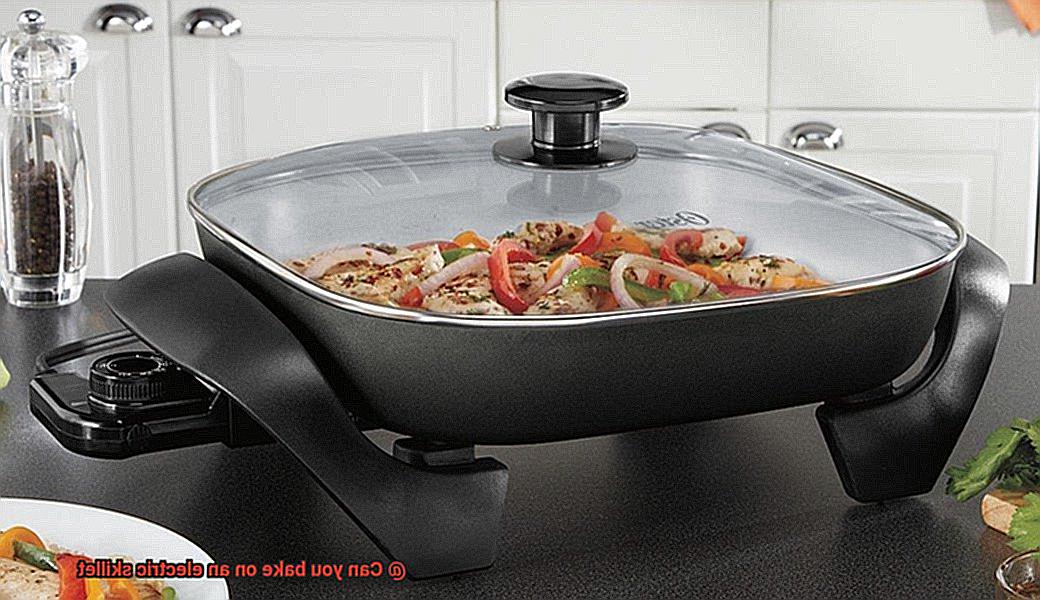
Remove and Cool
Once your baked goods are finished, carefully remove them from the electric skillet using oven mitts or other heat-resistant tools. Let them cool completely before serving or storing.
Tips for Even Heat Distribution and Temperature Control
Baking on an electric skillet can be a convenient and efficient way to create delicious baked goods. However, achieving even heat distribution and temperature control can be a challenge. Here are some tips to help you get the perfect bake every time:
Preheat your electric skillet
One of the most important tips for even heat distribution is to preheat your electric skillet before adding your baking dish. This allows the skillet to reach a consistent temperature throughout, preventing any hot spots from developing. A consistent temperature ensures that your baked goods cook evenly.
Use a heat diffuser
Another effective way to promote even heat distribution is to use a heat diffuser. The flat metal plate sits between the electric skillet and the cooking vessel, such as a baking dish or cake pan. It helps to distribute heat more evenly across the surface of the dish, preventing hot spots and ensuring that everything cooks at the same rate.
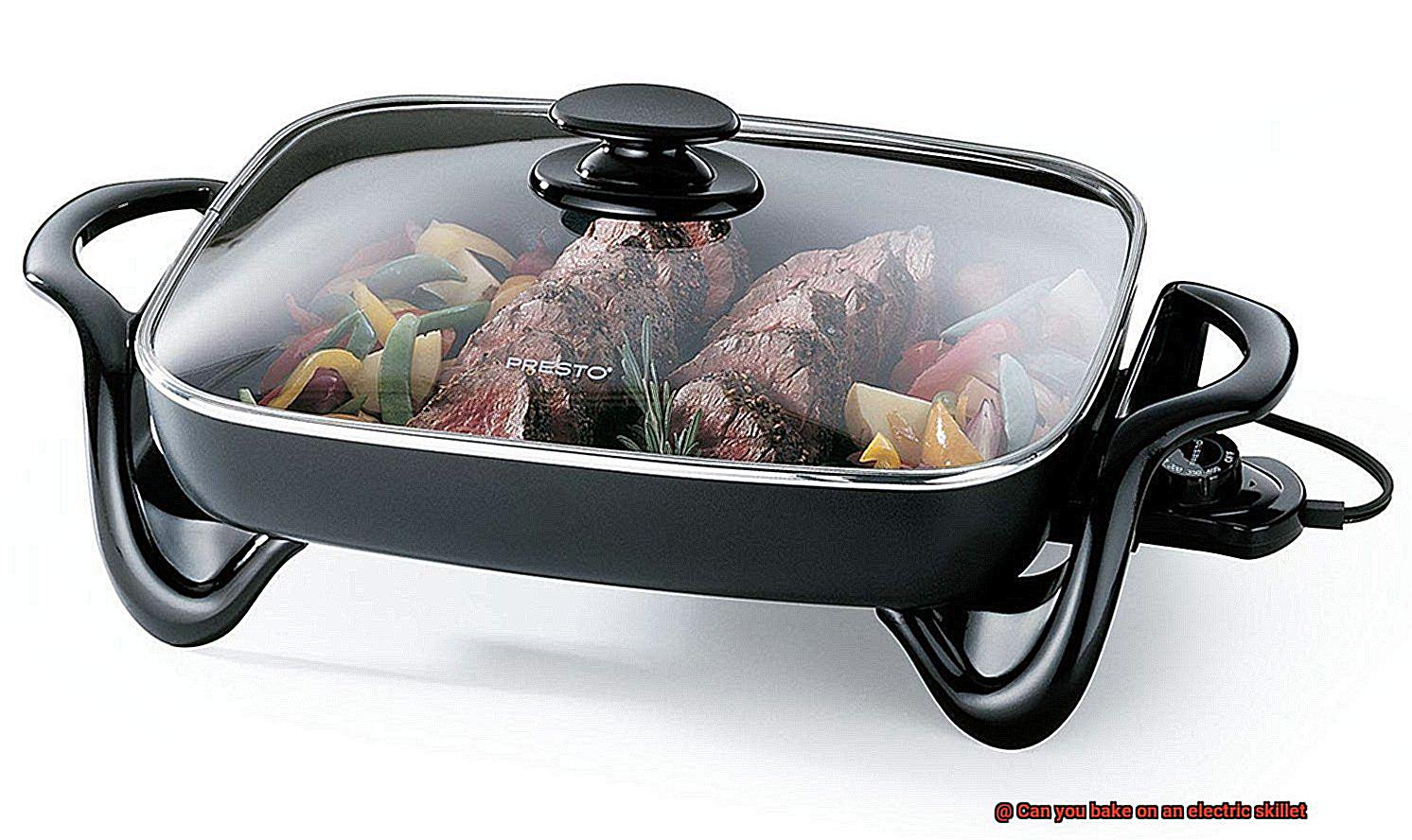
Control the temperature
Temperature control is crucial when baking on an electric skillet. Many electric skillets come with temperature controls, but it’s important to monitor the temperature closely throughout the baking process. Using an oven thermometer can help ensure that the temperature remains consistent and that your baked goods are cooking at the correct temperature.
Use a lid
One of the lesser-known tips for even heat distribution is to use a lid on your electric skillet. This traps in heat, creating a more oven-like environment which can be especially helpful when baking items like bread or cakes. The lid also helps to distribute heat more evenly throughout the baking dish.
Flip or rotate your baked goods
Flipping or rotating your baked goods during cooking can help promote even heat distribution and prevent hot spots from developing. For example, if you’re baking a cake on an electric skillet, rotating it 180 degrees halfway through the cooking time can help ensure that both sides of the cake cook evenly.
Common Mistakes to Avoid When Baking on an Electric Skillet
Whether you’re a seasoned baker or a beginner, using an electric skillet can be a game-changer. However, there are some common mistakes that can lead to less-than-perfect results. As an expert in this field, let me share with you some tips on how to avoid these mistakes and achieve perfect bakes every time.
Firstly, not preheating the skillet is one of the most common mistakes. It’s crucial to preheat the skillet for at least 10 minutes before adding any batter or dough. This will ensure even cooking and perfect results. Remember, patience is key.
Secondly, using the wrong temperature setting on your electric skillet can be disastrous. Always consult the recipe and adjust the temperature accordingly. If you’re not sure about the right temperature, it’s best to start with a lower temperature and increase it gradually. This will prevent burning or undercooking your baked goods.
Thirdly, overcrowding the skillet is a mistake that can lead to uneven cooking and unsatisfactory results. Make sure to leave enough space between each item so that they can cook evenly. It’s better to bake in smaller batches than to overcrowd the skillet.
Fourthly, using enough oil or butter is essential for preventing sticking and ensuring even cooking. Coat the skillet evenly before adding any batter or dough. Don’t be afraid to use more oil or butter than you think is necessary.
Lastly, opening the lid too often can cause temperature fluctuations and uneven cooking. Keep the lid closed as much as possible and only open it when necessary. This will help maintain a consistent temperature and ensure even baking.
Different Types of Dishes that Can Be Baked in an Electric Skillet
If you’re on the hunt for new and exciting ways to bake delicious dishes, your electric skillet is the perfect tool. With its even heat distribution and versatility, an electric skillet can be used to create an array of baked dishes that will impress your family and friends.
One classic dish that can be easily made in an electric skillet is cornbread. The evenly heated skillet ensures that the cornbread comes out perfectly cooked and moist. Plus, it’s incredibly easy to mix up the batter and pour it into the skillet for a quick and delicious side dish that pairs perfectly with any meal.
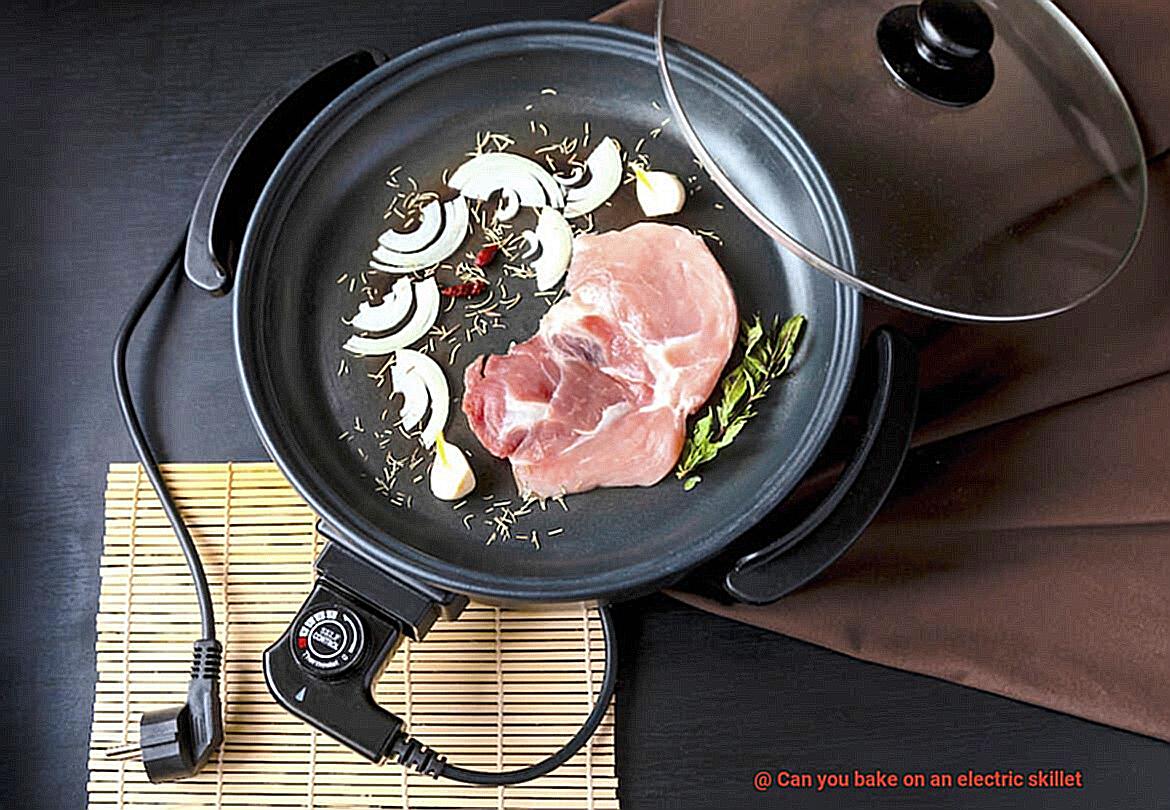
For a savory option, consider making a frittata in your electric skillet. These egg-based dishes can be filled with a variety of ingredients such as veggies, cheese, and meats, making them a great way to use up leftovers. Simply mix up your ingredients, pour them into the skillet, and bake until the eggs are set. The result is a flavorful and protein-packed dish that’s perfect for breakfast, lunch, or dinner.
If you have a sweet tooth, try making an apple crisp in your electric skillet. The skillet can be used to layer sliced apples with a mixture of oats, brown sugar, and cinnamon for a quick and easy dessert that’s perfect for fall. The result is a warm and comforting dessert that will satisfy any sweet craving.
If you’re looking for something more substantial, consider making a baked pasta dish like lasagna or baked ziti in your electric skillet. Layer cooked pasta with sauce, cheese, and any desired toppings in the skillet and bake until bubbly and golden brown. This dish is perfect for feeding a crowd or meal prepping for the week ahead.
Finally, don’t forget about desserts. An electric skillet is perfect for baking cakes and other sweet treats. With its even heat distribution, you can ensure that your cakes come out perfectly every time. From classic chocolate cakes to fruity flavors like lemon or strawberry, the possibilities are endless.
Cleaning and Maintenance Tips for Electric Skillets
If so, proper cleaning and maintenance are essential to ensure it lasts for years to come. Neglecting to take care of your skillet can lead to decreased performance and even damage. Here are five important sub-sections outlining how to keep your electric skillet in excellent condition:
Unplug before cleaning
Always unplug the skillet before cleaning it. This is crucial for safety reasons, as hot surfaces can cause burns and damage to the skillet’s non-stick coating.
Use gentle materials
Allow the skillet to cool completely before washing it with warm, soapy water and a soft sponge or cloth. Avoid using harsh chemicals or abrasive materials that can damage the non-stick surface.
Soak for tough stains
If there are stubborn stains or residue on the surface, try soaking the skillet in warm water with a small amount of dish soap for 10-15 minutes before wiping it clean. Never use steel wool or abrasive brushes on the skillet, as this can scratch the surface and compromise its non-stick properties.
Regularly oil
To keep the non-stick surface in good condition, regularly oil it with a small amount of vegetable or canola oil on a paper towel or cloth and rub it onto the surface before each use.
Store properly
Finally, store the electric skillet in a dry place with its lid off to prevent any moisture buildup that can lead to rust or corrosion.
Conclusion
To sum up, an electric skillet is a jack-of-all-trades kitchen gadget that can do more than just fry and sauté. It can also be used for baking, but there are a few things to keep in mind before you start whipping up your favorite treats.
Firstly, make sure you find a recipe that doesn’t require an oven temperature higher than 400°F. Secondly, check that your skillet is large enough to fit your baking dish comfortably. Lastly, don’t forget to adjust your cooking time and technique accordingly.
The benefits of using an electric skillet for baking are numerous. It’s versatile, saves space in the kitchen, and offers even heat distribution with precise temperature control. Plus, it can be faster and more energy-efficient than using a traditional oven.
However, it’s crucial to consider the type of dish you want to bake and choose recipes that can adapt to the temperature range of your electric skillet or invest in one with adjustable temperature controls. And remember, baking on an electric skillet may take some trial and error before achieving perfect results.
With some patience and persistence along with proper cleaning and maintenance tips like using gentle materials for cleaning and regularly oiling the non-stick surface of the electric skillet will help ensure that this multi-functional tool lasts for years to come.

